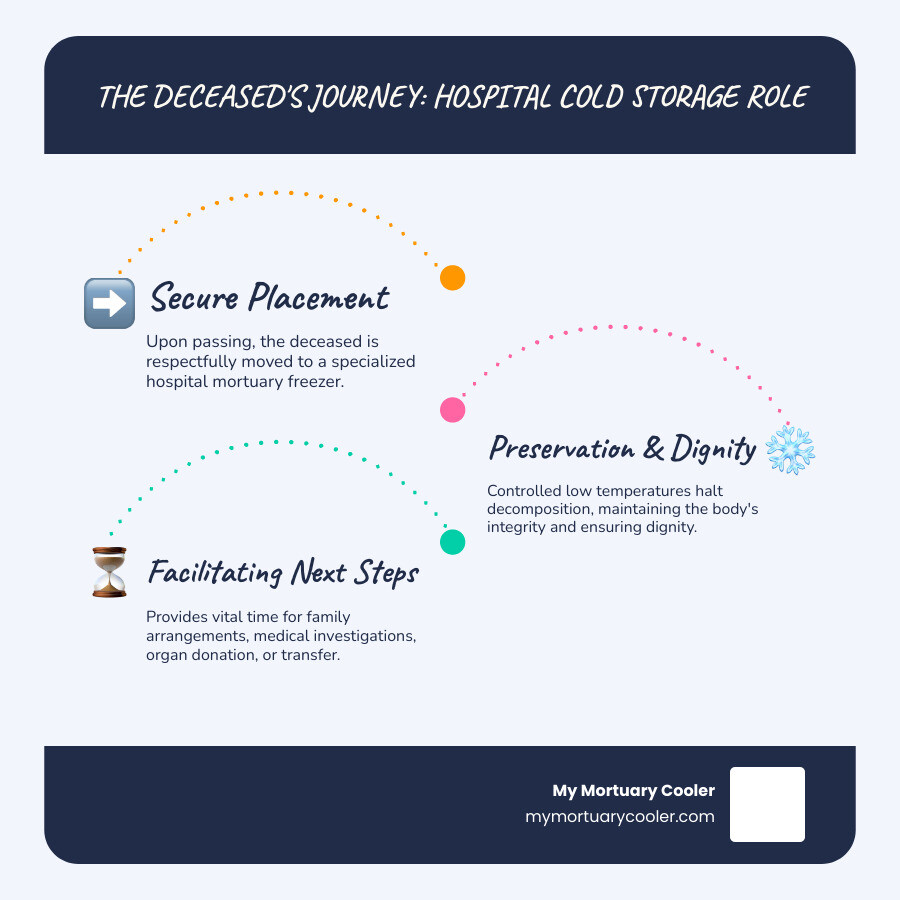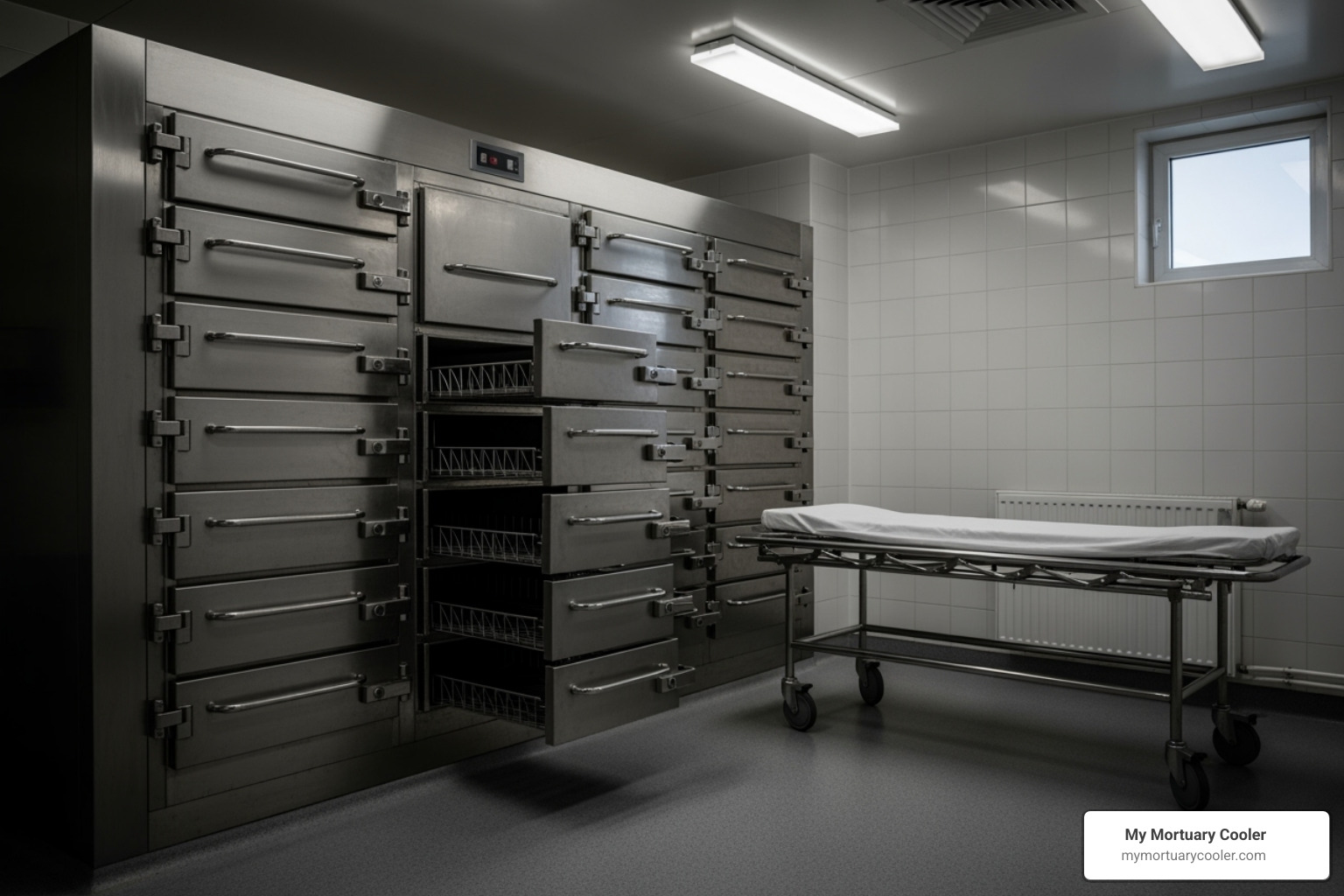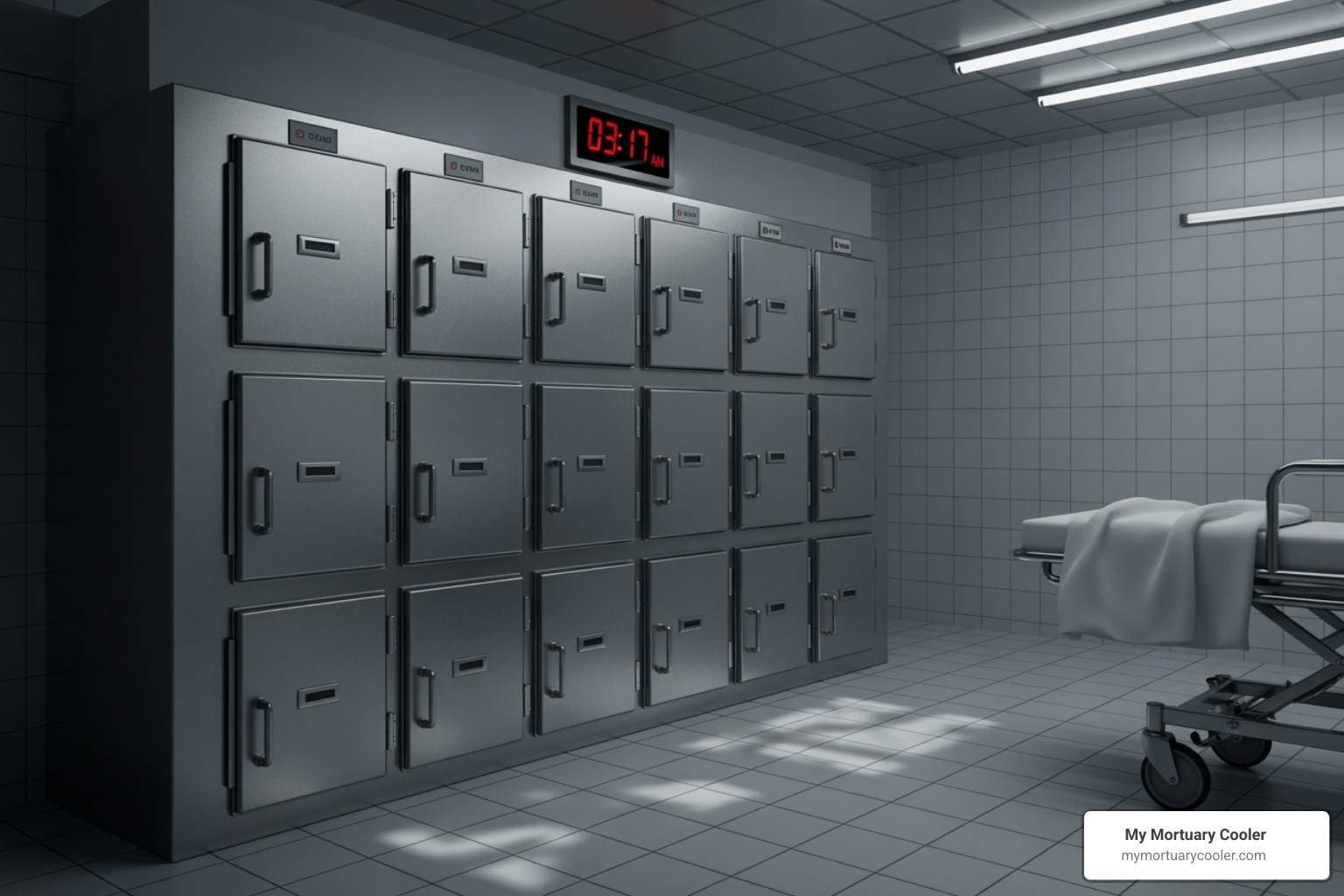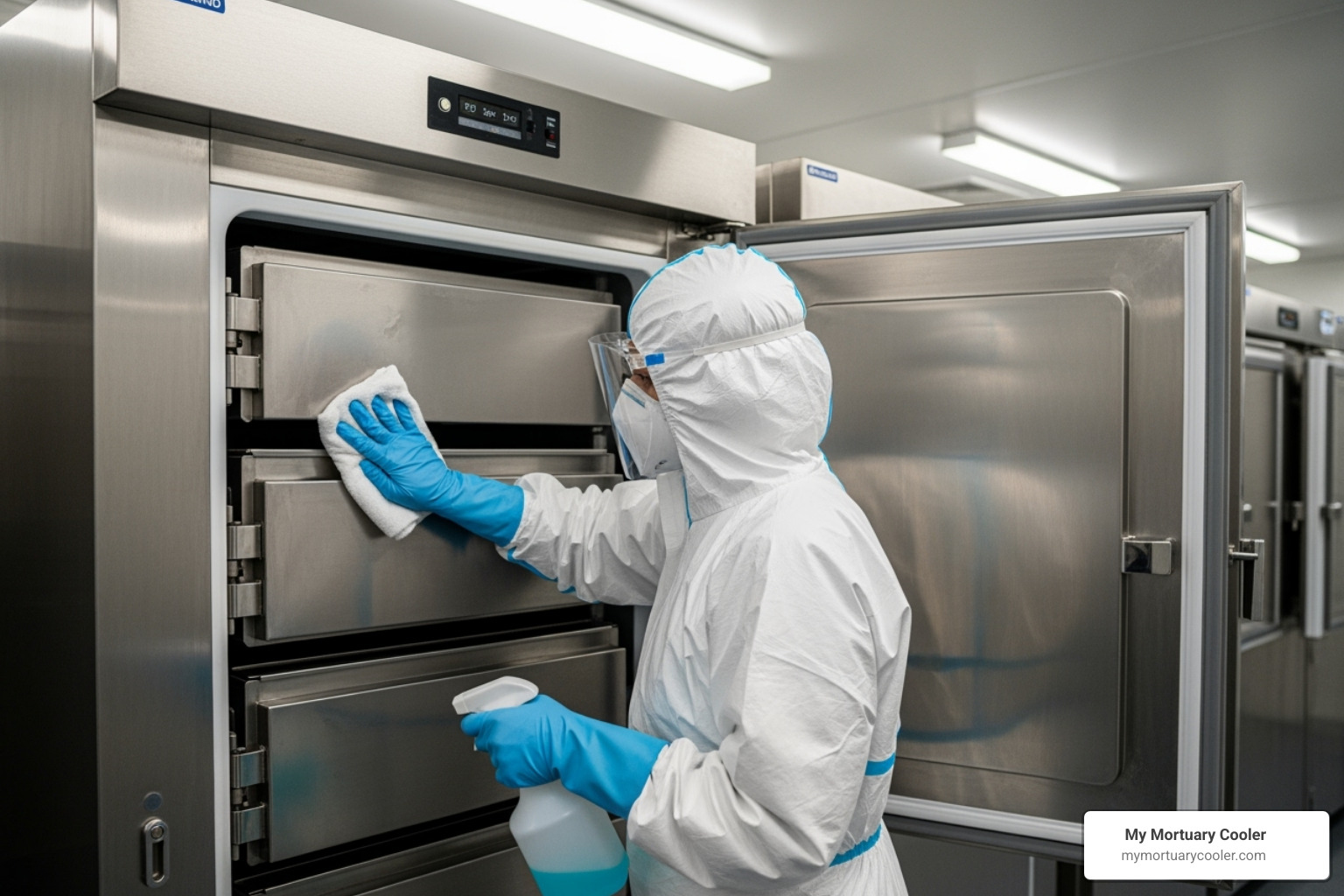Understanding the Hospital Mortuary Freezer
A hospital mortuary freezer is a specialized refrigeration unit designed to safely store deceased individuals, ensuring dignity and preventing decomposition. It is a critical component of any hospital's operations.
What does a hospital mortuary freezer do?
- Preserves Bodies: It maintains optimal temperatures to slow or halt the natural decomposition process.
- Ensures Dignity: By preserving the body's condition, it allows families to grieve and make arrangements respectfully.
- Supports Investigations: It keeps bodies in a stable state for identification, autopsies, or forensic examinations.
- Facilitates Hospital Workflow: It provides temporary, secure storage until bodies can be transferred to funeral homes or other facilities.
For professionals in the mortuary, funeral, or forensic industries, a reliable hospital mortuary freezer is vital for compassionate post-mortem care. These specialized units create a controlled environment that prevents decay and maintains the deceased's condition. This preservation allows families time to make funeral arrangements and supports important medical or legal investigations.
A well-chosen mortuary freezer ensures respect for the deceased and maintains an efficient workflow for staff. This guide will help you understand these essential units.

Understanding the Fundamentals: How Mortuary Freezers Preserve and Protect
A hospital mortuary freezer uses low temperatures to preserve human remains by fighting the natural process of decomposition. When a body is placed in a professional unit, the cold slows or stops cellular breakdown and bacterial activity, which are the primary causes of decay.
The science behind this preservation is cold. By significantly lowering the temperature, the metabolic processes of bacteria are slowed, much like refrigerating food to extend its freshness. In a mortuary freezer, this principle is applied with greater precision and power to keep the body in a stable condition for hours, days, or even longer for investigations or family arrangements.
These units achieve and maintain cold temperatures using a refrigeration cycle. A special liquid refrigerant circulates through a closed system of coils, absorbing heat from inside the unit and releasing it outside. This constant cycle ensures a steady, precise temperature, which is key for proper preservation.
Effective insulation is also vital. Our mortuary freezers use thick, high-density polyurethane (PUF) foam (around 100mm or 4 inches) to create a barrier against external warmth. This not only keeps internal temperatures stable but also improves energy efficiency, reducing operational costs and extending the unit's lifespan. Every detail, from cooling pipelines to door seals, is engineered for durability and performance.

Positive vs. Negative Temperature Storage
Mortuary cooling units come in two main types, each designed for different needs. Understanding the difference is crucial for selecting the right hospital mortuary freezer.
Positive temperature units, or mortuary refrigerators, keep bodies above freezing, typically between 2°C to 5°C (36°F to 41°F).
- What they do: They are designed for short-term storage, significantly slowing decomposition. They keep the body in good condition for days or a few weeks without freezing it solid.
- Where they're used: Common in hospital mortuaries for temporary holding before transfer to funeral homes, for identification, or while awaiting an autopsy.
Negative temperature units are true mortuary freezers, maintaining temperatures below freezing, usually from -10°C to -25°C. Some professional-grade freezers can reach -30°C or lower with 0.1°C accuracy.
- What they do: These units are for long-term storage. They halt the decomposition process by freezing the body, which almost completely stops cellular and microbial activity.
- Where they're used: Essential in forensic institutes to preserve evidence in complex investigations or for unidentified bodies requiring long-term storage. They are also used in disaster situations or for specific research.
Here’s a quick look at the differences:
| Feature | Positive Temperature Mortuary Unit (Refrigerator) | Negative Temperature Mortuary Unit (Freezer) |
|---|---|---|
| Temperature Range | 2°C to 5°C (typically) | -10°C to -50°C (typically) |
| Primary Function | Slows decomposition | Halts decomposition (freezes) |
| Storage Duration | Short-term (days to a few weeks) | Long-term (weeks, months, or longer) |
| Common Applications | Hospital temporary holding, funeral homes | Forensic labs, unidentified bodies, long-term preservation |
| Body Condition | Refrigerated, not frozen | Frozen solid |
The Critical Role in Hospital and Forensic Settings
A properly working hospital mortuary freezer is essential in healthcare and forensic systems. These units are vital for showing respect after death, supporting legal processes, and protecting public health.
In hospitals, mortuary freezers perform several important jobs:
- Awaiting Family Arrangements: They provide a dignified holding space while families grieve and make funeral plans, ensuring the deceased's condition remains stable for viewings.
- Pending Autopsy: If an autopsy is needed, the freezer preserves the body in a stable state, preventing changes that could interfere with the examination.
- Organ and Tissue Donation: For donors, rapid preservation is critical. Our units help maintain the viability of organs and tissues until retrieval.
- Investigations and Documentation: The freezer ensures the body is perfectly preserved during administrative or legal delays.
For forensic investigations, a negative temperature hospital mortuary freezer is even more critical:
- Preserving Evidence: In suspicious deaths, freezing halts decomposition, protecting trace evidence, tissue quality, and other forensic details.
- Minimizing Tissue Degradation: Freezing stops enzymes and bacteria from breaking down tissues, ensuring pathology samples are as accurate as possible.
- Unidentified Bodies: When a body is unidentified, long-term storage is often necessary. Negative temperature storage keeps the body stable throughout this process.
Beyond these settings, our mortuary freezers are also vital in:
- Funeral Homes: For short-term holding before embalming, cremation, or burial.
- Medical Examiner Offices: For investigations, autopsies, and long-term evidence storage.
- Disaster Camps and Military Units: For managing deceased individuals in mass casualty situations or remote locations.
Choosing the Right Hospital Mortuary Freezer: A Specification Checklist
Selecting the right hospital mortuary freezer is an investment in professional, compassionate care. It ensures your facility runs smoothly, upholds standards, and treats the deceased with dignity.

Start by examining the construction materials, which indicate a unit's durability, hygiene, and overall quality. For hospital mortuary freezers, high-quality 304-grade stainless steel is the industry standard for both the interior and exterior.
Why is stainless steel ideal?
- Durable: It withstands the demands of a busy medical facility without denting or damage.
- Hygienic: Its smooth, non-porous surface is easy to clean and sanitize, which is critical for infection control.
- Corrosion-Resistant: It resists rust and degradation from cleaning agents or biological fluids, ensuring a long service life.
Next, consider capacity and configuration. The right size depends on your facility's volume and specific needs. Units range from single-body designs to multi-body units holding 2 to 9 individuals or more. We offer flexible choices, from models like BK-XG1 (one body) to BK-XG6 (six bodies), to ensure you have the right amount of space.
Think about your workflow. Front-loading units are common and space-efficient, while side-loading units may suit certain layouts or larger cold rooms. We can customize systems for either door orientation. It's also important to plan for bariatric considerations, ensuring the unit's internal size and stretcher trays can accommodate larger individuals.
Essential Technical and Safety Features for Your Hospital Mortuary Freezer
Technical and safety features distinguish an adequate hospital mortuary freezer from an outstanding one. These elements ensure preservation, staff safety, and the dignity of the deceased.
Precise temperature control systems are crucial:
- Look for advanced Digital PID controllers for superior accuracy and temperature stability.
- Our units offer a high-accuracy display of 0.1°C, with adjustments down to 0.1°C, ensuring the environment stays exactly where it needs to be, from 2°C to 5°C for refrigeration or -30°C for a deep freeze.
- For multi-compartment units, individual chamber control is a major advantage, as opening one door won't affect the others. Some units feature separate compressors for each chamber.
A reliable alarm system provides critical alerts if something goes wrong:
- High/low temperature alarms signal if the interior gets too warm or cold.
- Power failure alerts notify you immediately if electricity is lost.
- Alarms should provide both audio and visual signals to ensure they are noticed in a busy environment.
Safety and security features protect the freezer's contents and your staff:
- Keyed door locks are essential to prevent unauthorized access.
- Sturdy roller trays made of stainless steel glide smoothly, making it easier and safer to move bodies and reducing physical strain on staff. Trays typically hold about 150 kg, with bariatric options available.
- An integrated frame door design ensures a tight seal, which is vital for maintaining consistent internal temperatures.
Here are our top 5 safety features to look for in a hospital mortuary freezer:
- High-Accuracy Digital Temperature Control with 0.1°C Precision: Ensures optimal preservation.
- Comprehensive Audio-Visual Alarm System: Provides immediate alerts for temperature deviations, power failures, or malfunctions.
- Secure, Keyed Door Locks: Prevents unauthorized access and maintains security.
- Heavy-Duty Stainless Steel Roller Trays: Facilitates safe, ergonomic handling of bodies.
- Robust Polyurethane Insulation with Quality Door Seals: Guarantees temperature stability and energy efficiency.
Environmental and Installation Considerations for a Hospital Mortuary Freezer
A responsible purchase also involves considering environmental impact and installation requirements. These factors affect long-term operating costs and ensure the unit fits properly in your facility.
Our professional-grade units use eco-friendly, CFC-free refrigerants like R-134a or R406A, which do not harm the ozone layer.
Energy efficiency is also important, as these units run 24/7:
- Superior high-density PUF insulation (around 100mm thick) minimizes energy consumption by keeping cold air in.
- Quality door seals prevent cold air leaks, a common source of energy waste in less efficient units.
- For multi-body units, individual compressor systems can be more energy-efficient, as each compartment is cooled independently.
Proper installation is key to optimal performance and longevity:
- Ensure adequate space and ventilation around the unit for the compressor and condenser to prevent overheating.
- Check the floor load capacity. A fully loaded multi-body freezer can be very heavy (a 6-body unit can weigh over 840kg before bodies are added), and your floor must support it.
- A backup power system (UPS) is highly recommended to keep the refrigeration running during power outages.
- The location of the morgue should be discreet, away from public areas, and on the ground floor if possible to ensure privacy and respect. Also consider ADA accessibility guidelines. You can find more detailed guidance in the Hospital Morgue Design Guidelines.
Compliance, Maintenance, and Ensuring Respectful Operation
Operating a hospital mortuary freezer involves adhering to strict regulations, performing regular maintenance, and always acting with respect. Our equipment is designed to help you meet these responsibilities in a caring and compliant environment.
Regulatory Standards
Handling human remains is governed by important legal and ethical rules. Our professional-grade products are built to help your facility meet key requirements.
OSHA Compliance is critical for employee safety. The Occupational Safety and Health Administration (OSHA) sets standards for safe body handling with roller trays and hygiene protocols to prevent infections. Our units' features help create a safer workplace.
Facilities must also follow local health codes, which vary by location. Ensure your hospital mortuary freezer and its operational procedures meet all local and national health and safety regulations.
Hospital Morgue Design Guidelines, such as those from QSCH, offer detailed advice on morgue design, including body storage, temperature monitoring, and infection control. Reviewing these guidelines helps ensure your facility follows best practices. You can find more details here: Hospital Morgue Design Guidelines.
Cleaning and Sanitation Protocols
Impeccable cleanliness is vital in a mortuary for public health and as a sign of respect for the deceased. Our units are constructed with 304-grade stainless steel, a durable and non-porous material that does not absorb fluids, making it easy to sanitize.
Regular, thorough cleaning with appropriate disinfectants is essential. The smooth surfaces and effective drainage systems in our units simplify this process for your staff, allowing for quick and effective cleaning of chambers and trays after each use.

Routine Maintenance
Regular maintenance ensures your hospital mortuary freezer operates efficiently and has a long service life.
An important task is checking seals. Periodically inspect door seals for wear or damage, as faulty seals let cold air escape and increase energy consumption. Our units feature high-quality, durable door seals, but regular checks are still recommended.
Calibrating thermostats is key to maintaining precise temperatures. Our systems offer 0.1°C precision, and routine calibration helps maintain that accuracy.
Finally, schedule professional servicing. Qualified technicians should inspect refrigerant levels, compressors, condensers, and all electrical components and alarms. The copper cooling pipelines in our units are built for longevity, and professional check-ups ensure they remain in top condition.
Frequently Asked Questions about Hospital Mortuary Freezers
When considering a hospital mortuary freezer, healthcare professionals often have similar questions. Here are answers to the most common inquiries we receive about our professional-grade equipment.
What is the typical lifespan of a hospital mortuary freezer?
A well-built hospital mortuary freezer is a long-term investment. With proper care, professional-grade units can serve a facility for 20 to 30 years or more.
Build quality is the most important factor. Units made from 304-grade stainless steel with robust components like copper cooling pipelines are designed to withstand 24/7 operation.
Your maintenance schedule is also crucial. Regular cleaning, checking door seals, and scheduling professional servicing for the cooling system will significantly extend the unit's operational life.
Usage frequency and environmental conditions also play a role. While a busy hospital will see more activity, robust units are designed for heavy use. Proper ventilation around the unit reduces strain on components and extends its lifespan.
How much space is needed for installation?
Planning your installation space requires more than just the freezer's dimensions. You must create a functional and dignified workspace.
Maneuvering space for trolleys is critical. You need clear space around the hospital mortuary freezer for staff to safely move body trolleys. Design guidelines suggest about 3 square meters for maneuvering a trolley, with more space needed for bariatric cases.
Ventilation clearance for compressors is a non-negotiable requirement. Refrigeration systems generate heat and need adequate airflow to prevent overheating and component failure. Always follow the manufacturer's minimum clearance recommendations.
Also, ensure there is clear access for maintenance on all sides of the unit, especially near mechanical components.
ADA accessibility requirements for pathways and door widths must be considered for the entire morgue layout to serve staff and any visiting family members.
Can a single unit have both refrigerated and freezer compartments?
Yes. While many facilities use separate refrigerators and freezers, dual-temperature units offer excellent flexibility.
Custom configurations allow for multi-chamber hospital mortuary freezers where some compartments maintain positive temperatures (2°C to 5°C) for short-term storage, while others operate at negative temperatures (-10°C to -30°C) for long-term or forensic use.
The key is individual chamber controls. Each compartment requires its own temperature controller and often its own compressor system. This allows for completely independent temperature settings within a single unit, making it a space-efficient solution for facilities with diverse needs.
Conclusion: Making an Informed and Compassionate Choice
Choosing a hospital mortuary freezer is a decision that reflects your facility's commitment to honoring the deceased, supporting families, and equipping your staff with the best tools for their vital work.
As you make this choice, remember the key considerations from this guide. Evaluate your needs for capacity, including bariatric cases, and determine the required temperature range for short-term or long-term preservation. Prioritize durable materials like 304-grade stainless steel and essential safety features like secure locks and reliable alarms. Finally, ensure your choice meets all compliance standards.
A well-chosen hospital mortuary freezer upholds dignity for the deceased, offers peace of mind for families, and provides a safe, efficient environment for your staff.
At My Mortuary Cooler, we understand these responsibilities. As America's trusted authority in mortuary refrigeration, we are committed to offering professional-grade, OSHA-compliant equipment. We want to empower you to make an informed and compassionate choice for your facility.
Ready to take the next step in optimizing your operations? Explore our comprehensive guide to mortuary freezers and coolers to improve your facility's operations.
















